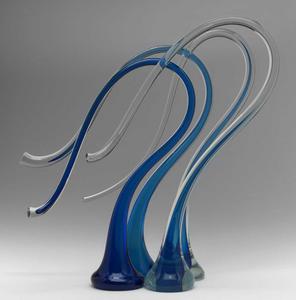

In this Lyrical Movement sculpture by Harvey Littleton, Judy Moore says, "the form flows so freely you can almost hear music."
Five years ago A! Magazine for the Arts featured an extensive private collection of studio glass at the home of Jim and Judy Moore in Abingdon, Va. When we began working on a story about the glass art exhibit at Emory & Henry College, we called the Moores, who are considered experts on the subject of studio glass.
Judy Moore says, "We started collecting Harvey Littleton's pieces because of his stature in the glass art world - and because we met him years ago, and his knowledge and enthusiasm inspired us. We also love his simplicity - especially when compared to other sculptures which are being created today. We made a decision long ago to collect from artists on the East Coast. This may be a little bold, but I doubt there are very many people in the U.S. who have a collection that spans the breadth of Littleton's artistic career."
According to Judy, "There is something quite special, almost magical, about looking at one of Littleton's four Lyrical Movements. The form flows so freely that, when you do get the time to really study it, you can almost hear music. The four pieces together are rather simplistic - when compared to glass sculptures that have been produced within the last 10-15 years -but you have to remember that the technology was so much different back when Littleton was creating his glass pieces. We own one of Littleton's blue Lyrical Movements, which we purchased from him at his studio in Spruce Pine, NC. Our piece had been in every show around the world while Littleton was active in his career, and it was also on the cover of several catalogues, when the Studio Glass Movement was developing in the 1970s and early '80s."
Judy continues, "When Littleton was creating his elegant, curved and linear glass pieces, he had had very little technical training in glass blowing. After he created the furnace, with the help of Dominick Labino, in Toledo, Ohio, Littleton really didn't know what to do next, so he had to experiment long and hard to come up with even his most simplistic pieces. I would like to call him a pioneer in all aspects of the Studio Glass Movement - he was the first to announce it was 'form not function,' which really got the Studio Glass Movement on its way."
She notes, "Littleton's glass program at the University of Wisconsin produced many of the other early glass pioneers who went on to establish glass programs across the country, and these artists are now internationally well known. Even today, established glass artists consider it a privilege to have the opportunity to work with Littleton in his vitreograph studio."
One of those artists, Thermon Statom, has been to the Moores' home twice to install his impressive artwork. Judy says, "One of the pieces has been described as defying gravity and the imagination. He was assisted by Littleton's daughter Maureen who owns an art gallery in Georgetown, DC."
READ ON:
Artist profile: Dale Chihuly
About the Exhibit: "Littleton, Chihuly & Friends"